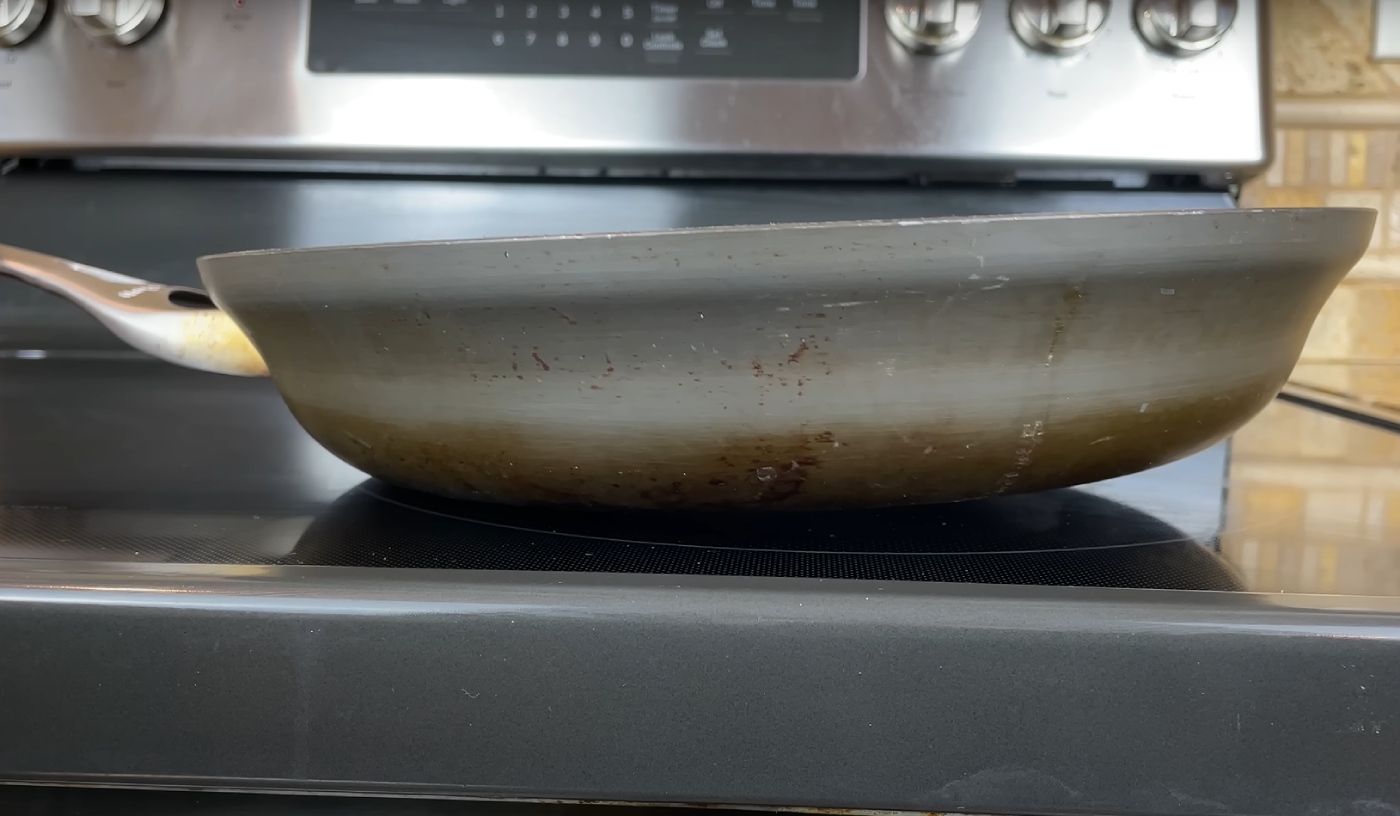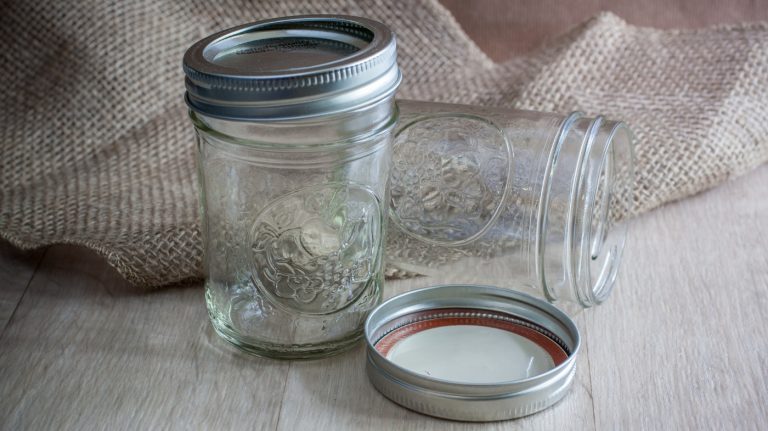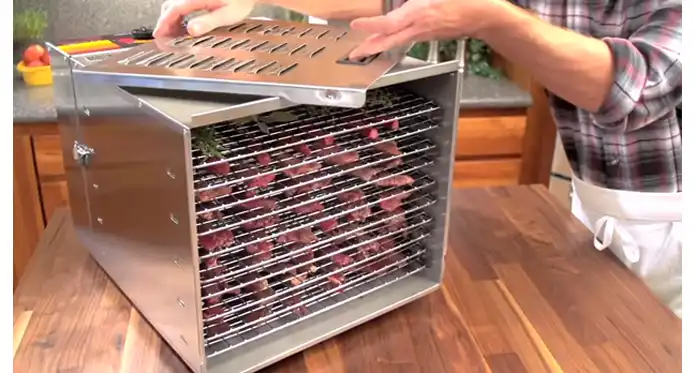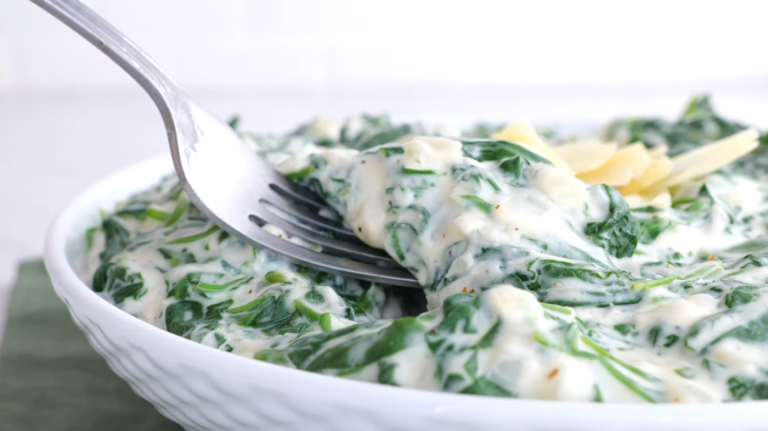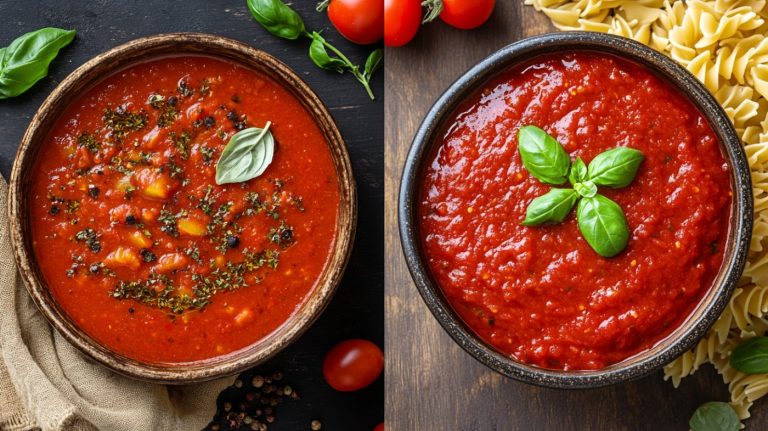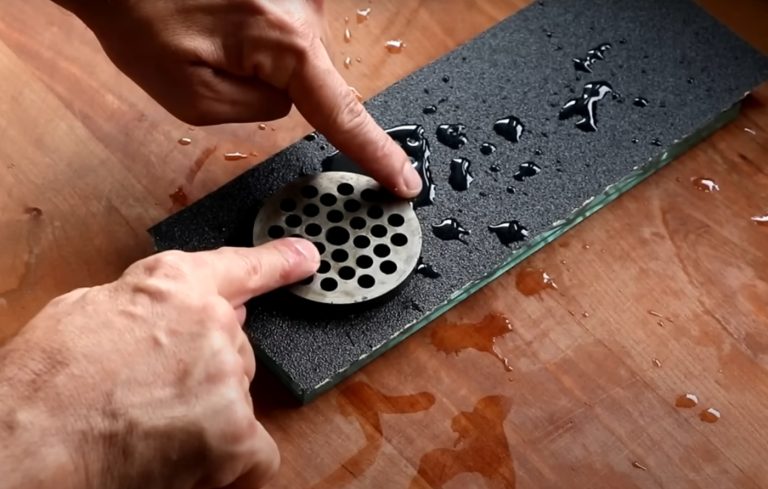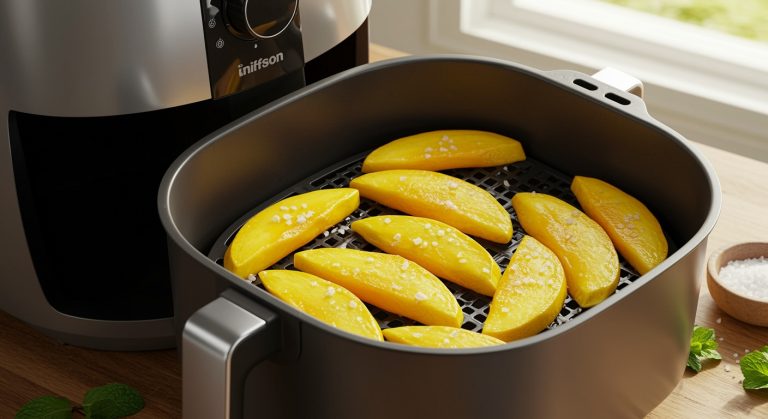How to Fix a Warped Pan: Proven Techniques to Restore It
To fix a warped pan, start by heating it on medium for 15-20 minutes to enhance its malleability. Use a weighted nylon hammer and a wooden support that matches the pan’s diameter, placing the pan upside down with the warped side facing up.
Gently tap the wood, applying even pressure on raised areas. Regularly check the shape to achieve the desired flatness.
Keep in mind that some DIY methods may not fully restore your pan’s functionality, and for severe warping, consider replacement. Explore further techniques to guarantee your cookware remains efficient and long-lasting.
Key Takeaways
- Use a rubber mallet and wood support to gently tap and reshape the warped areas of the pan.
- Heat the pan on medium for 15-20 minutes to improve malleability before attempting to flatten it.
- Ensure that pressure is even applied to raised areas to avoid creating additional dents during the hammering process.
- Consider investing in high-quality cookware made from stainless steel or cast iron to reduce future warping risk.
- If severe warping persists, replacement may be more effective than DIY repairs for optimal cooking performance.
Common Causes of Pan Warping
Warping is a frustrating issue that can stem from several common practices in the kitchen. One of the primary causes is overheating an empty pan. When you heat a pan without contents, it can weaken the metal structure, making it more susceptible to warping.
Additionally, rapid temperature changes, like pouring cold water onto a hot pan, create thermal shock that distorts the metal. This sudden shift can lead to permanent deformation.
Another factor to take into account is the use of small burners with large pans. This setup often causes uneven heating, which results in warping in areas that receive excessive heat.
Furthermore, pans made from thin materials are particularly vulnerable. Their inability to handle high heat and maintain even temperature distribution greatly increases the risk of warping.
Finally, low-quality materials, such as inexpensive aluminum, often lack the structural integrity needed to resist warping over time.
Effects of Warped Pans
Warped pans compromise your cooking efficiency by creating uneven surfaces that lead to inconsistent heating.
This results in heat distribution issues, making it difficult for your food to cook evenly and reach safe temperatures.
Cooking Efficiency Compromise
Cooking with a warped pan can severely compromise your efficiency in the kitchen. When you use warped pans, you face significant challenges in achieving consistent cooking results.
Their irregular shape leads to uneven heat distribution, causing some food areas to overcook while others remain undercooked. This inconsistency not only affects your cooking time but also the quality of the final dish.
Additionally, the wobbliness of a warped pan means it often doesn’t make full contact with the cooking surface. This prevents ideal heat retention and absorption, leading to temperature drops whenever you add ingredients. As a result, you’re likely to experience longer cooking times, which can be frustrating.
The curvature of the pan can hinder proper searing and browning, which are essential for enhancing flavor and texture. Furthermore, using a warped pan increases the likelihood of food sticking to the surface, complicating both the cooking and cleanup processes.
Heat Distribution Issues
Uneven heat distribution is a vital issue when using a warped pan, as it directly impacts the quality of your cooking. When the pan’s surface isn’t flat, it can lead to hot spots where food burns while other areas remain undercooked.
A warped pan often wobbles during cooking, hindering full contact with the heat source. This lack of proper contact further exacerbates the uneven heating, making it difficult to achieve consistent results. Additionally, warping can cause heat retention issues, leading to longer cooking times and wasted energy.
Warped pans pose even greater problems on induction and glass-top stoves. These stovetops depend on flat surfaces for ideal heat transfer, and any warping can severely compromise cooking performance. Consequently, your dishes may take longer to cook or fail to develop the intended flavors.
Techniques for Flattening Warped Pans
To effectively flatten a warped pan, you’ll want to employ specific hammering techniques, heat application methods, and wood support strategies.
Start by understanding how to use a weighted object or a rubber mallet to apply even pressure on the raised areas.
Additionally, heating the pan before manipulation can enhance its malleability, making the process smoother and more effective.
Hammering Techniques
When dealing with a warped pan, employing effective hammering techniques can restore its shape and functionality. Start by placing the pan on a flat, sturdy surface to guarantee even force is applied during the process. This support is essential for promoting effective flattening.
Before you begin hammering, position a piece of wood, such as a 2 x 4 board, against the pan’s bottom. This helps distribute the impact evenly and minimizes potential damage to the metal.
Use a rubber mallet to strike the pan gently; this method reduces surface damage compared to a metal hammer while still delivering sufficient force for reshaping.
If you notice significant warping, consider heating the pan on low heat for 5-10 minutes prior to hammering. This can increase the metal’s malleability, making it easier to flatten.
Regularly assess the pan’s shape throughout the hammering process. If needed, repeat heating and tapping to achieve the desired flatness without overstressing the material.
Heat Application Methods
Heating a warped pan effectively can greatly enhance its malleability, making the reshaping process much easier. To start, heat your pan on medium heat for about 15-20 minutes. This will prepare the metal for reshaping.
While heating, you can begin gathering your tools. A weighted nylon hammer is recommended for this process, as it minimizes the risk of surface damage compared to a steel hammer.
After heating, place a piece of wood cut to the pan’s diameter over the crown of the warped area. Gently tap with the nylon hammer to restore its flatness.
| Step | Action | Tools Required |
|---|---|---|
| 1 | Heat your pan | Stovetop |
| 2 | Place wood on the crown | Wooden piece |
| 3 | Tap gently with nylon hammer | Weighted nylon hammer |
| 4 | Repeat if necessary | Patience |
| 5 | Allow to cool naturally | Time |
You may need to repeat the heating and tapping process multiple times for persistent warping. After you’ve achieved the desired shape, let the pan cool naturally to maintain its new form.
Wood Support Strategies
Wood support techniques are essential for effectively flattening a warped pan. Begin by selecting a piece of wood that matches the pan’s diameter. This guarantees you have a stable surface to apply even pressure.
Position the pan upside down on a sturdy surface, with the bowed side facing up. Place the wood directly on the highest point of the warp.
Before applying pressure, heat the pan on medium-high heat for 15-20 minutes. This step increases the malleability of the metal, making it easier to reshape.
Once heated, gently tap the wood with a mallet. This distributes force evenly over the pan’s surface, minimizing the risk of dents or further damage.
If your pan remains warped after the first attempt, don’t be discouraged. Repeat the heating and tapping process in multiple sessions.
Gradually restoring its shape may take some time, but patience is key. By using these wood support strategies combined with heat application, you can effectively flatten your warped pan and extend its lifespan.
Limitations of DIY Solutions for Warped Pans
Although DIY solutions might seem appealing for fixing a warped pan, they come with significant limitations.
First, many DIY methods often fail to restore the pan to its original flatness, leaving you with a surface that’s still uneven. This can undermine the pan’s effectiveness, affecting your cooking results.
If you’re not experienced or lack proper techniques, you risk creating additional dents or lumps during the flattening process.
Achieving a truly flat surface requires skill and may necessitate multiple attempts, making DIY solutions time-consuming. You might find yourself investing more effort than it’s worth, especially when you could purchase a new pan that guarantees performance.
Additionally, the tools and materials needed for effective flattening, such as specific hammers or wood blocks, may not be readily available to everyone, limiting the feasibility of these DIY repairs.
For severe warping, methods like heating and tapping mightn’t yield satisfactory results, leading to the conclusion that replacement could be a more practical solution.
Alternatives to Repairing Pans
When repairing warped pans isn’t feasible, consider investing in high-quality cookware options that resist warping, such as stainless steel or cast iron, which are known for their durability and heat resistance.
Additionally, exploring materials like carbon steel for enhanced durability can be beneficial; these materials often offer impressive performance in the kitchen, much like the best black kitchen sinks that combine functionality with aesthetic appeal.
Alternatively, renting specialty cookware can provide access to premium options without a long-term commitment.
High-Quality Cookware Options
Investing in high-quality cookware can be a game changer for your kitchen. By choosing materials like stainless steel, cast iron, or anodized aluminum, you can greatly reduce the risk of warping compared to lower-quality options.
For instance, stainless steel’s corrosion resistance helps maintain its integrity over time, while heavy-bottomed pans enhance heat distribution, minimizing chances of warping and improving cooking efficiency.
Here are some excellent high-quality cookware options to take into account:
- Stainless Steel: Durable and resistant to warping, offering even heat distribution.
- Cast Iron: Known for its longevity and excellent heat retention; enameled varieties are easier to maintain.
- Blue/Black/Carbon Steel: Offers durability and resistance to warping, making it ideal for frequent use.
- Anodized Aluminum: Combines lightweight design with durability, reducing warping risks.
When selecting cookware, think about brands like All-Clad and Le Creuset that provide warranties. This added peace of mind guarantees you’re investing in products that can withstand the rigors of daily cooking.
Material Benefits Comparison
Choosing high-quality cookware helps prevent warping and informs how you can approach alternatives when faced with a warped pan. Understanding the material benefits can guide your decision-making process.
| Material | Benefits |
|---|---|
| Stainless Steel | Durable surface, resistant to warping |
| Cast Iron | Excellent heat retention, less prone to warping |
| Copper | Superior heat conductivity, uniform heating |
| Carbon Steel | Balances durability and performance |
Investing in steel pans, such as enameled cast iron or carbon steel, can enhance your cooking experience considerably.
These alternatives resist warping and provide a durable surface that withstands high temperatures. Heavy-bottomed pans, for example, distribute heat evenly, preventing deformation over time.
Quality Considerations in Cookware
When it comes to selecting cookware, the quality of the materials plays an essential role in performance and longevity. Opting for high-quality materials like stainless steel, cast iron, and copper can greatly enhance durability and resistance to warping.
These materials are designed to handle high heat effectively, making them ideal for various cooking techniques. Additionally, selecting cookware that features high-performance motors and durable designs can further improve cooking efficiency and outcomes.
Investing in thicker pans is also important. Thicker cookware conducts heat more evenly and can better withstand thermal stress compared to thinner alternatives, which are prone to warping under extreme conditions.
Multi-ply stainless steel cookware, with its layered construction, offers enhanced heat resistance and minimizes the likelihood of warping.
When choosing your cookware, prioritize materials with good thermal conductivity. This will help maintain consistent temperatures, reducing the risk of warping during cooking.
Prevention Strategies for Pan Warping
Selecting high-quality cookware is only the first step in ensuring its longevity; implementing effective prevention strategies is equally important. To keep your pans in prime condition and avoid warping, consider these key strategies:
- Gradually heat your pans by starting on low heat and slowly increasing the temperature. This minimizes thermal shock, which can cause warping.
- Avoid sudden temperature changes, such as pouring cold water on a hot pan. This creates stress in the metal, leading to deformation.
- Store your pans flat and avoid stacking heavy items on top. This prevents physical deformation and helps maintain their shape.
- Use high-quality cookware made from durable materials like stainless steel or cast iron. These materials are less prone to warping compared to lower-quality options.
Additionally, regularly inspect and maintain your cookware. Clean with non-abrasive materials to preserve the integrity and surface of your pans.
Repair Techniques for Fry Pans
A warped fry pan can be a frustrating issue, but several effective repair techniques can help restore its functionality.
First, you’ll want to heat it on medium for about 15-20 minutes. This process increases the metal’s malleability, making it easier to reshape. Once heated, position the pan with the bowed side facing up on a sturdy surface.
Next, take a wooden block and place it over the high point of the pan. This setup allows for better impact distribution when you begin to reshape.
Using a rubber mallet, gently strike the wooden block. Apply even pressure to flatten the pan without causing further damage.
You may need to repeat the heating and hammering process multiple times to achieve the desired flatness, so patience is key. Keep checking the pan’s progress as you work.
If, after several attempts, the pan remains notably warped or you’re not satisfied with the results, consider seeking professional repair services. They can provide the expertise needed to restore your fry pan’s functionality effectively.
Frequently Asked Questions
Can You Unwarp a Warped Pan?
Yes, you can unwarp a warped pan through careful heating and applying pressure. Using a rubber mallet and a flat surface can help. However, severe warping might require professional repair or replacement for best results.
Can You Fix a Warped Baking Pan?
Yes, you can fix a warped baking pan. Heat it gently to soften the metal, then tap the high points back into shape. Use a flat surface and a heavy object to maintain the new form.
How Do You Bend a Pan Back Into Shape?
Imagine a bow bending back to its original form. To reshape your pan, gently heat it, then place it upside down on a flat surface. Use a weighted object or rubber mallet to restore its shape.
Is a Warped Pan Ruined?
A warped pan isn’t necessarily ruined. You can still use it, especially if the warping is minor. However, severe warping can affect cooking efficiency and safety, so handle it with caution. Regular maintenance helps prevent warping.
Revive Your Warped Pan and Maximize Its Lifespan
Addressing a warped pan is essential for ideal cooking performance. Though the process may seem challenging, remember that even the most stubborn warping can often be remedied with the right techniques.
Think of your cookware as an investment; a little effort now can extend its lifespan considerably. By adopting preventive measures and understanding your pans better, you can keep your kitchen tools in peak condition, ensuring delicious meals for years to come.

